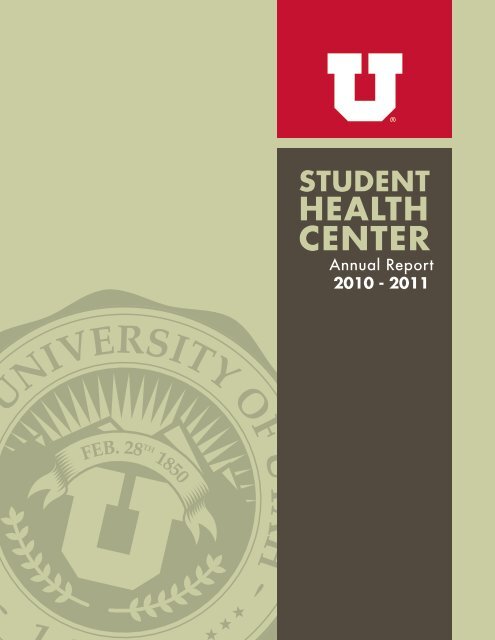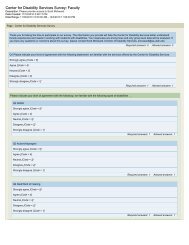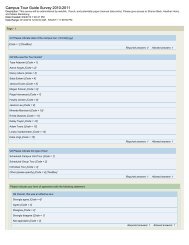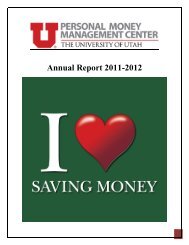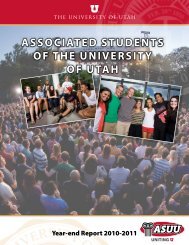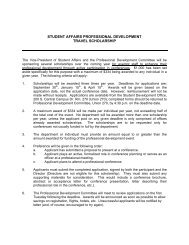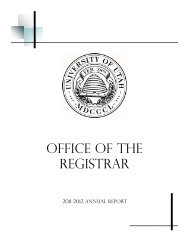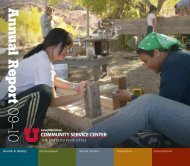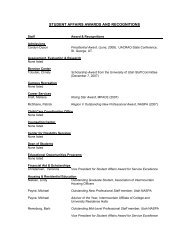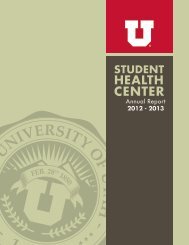CENTER - Student Affairs - University of Utah
CENTER - Student Affairs - University of Utah
CENTER - Student Affairs - University of Utah
Create successful ePaper yourself
Turn your PDF publications into a flip-book with our unique Google optimized e-Paper software.
STUDENT<br />
HEALTH<br />
<strong>CENTER</strong><br />
Annual Report<br />
2010 - 2011
Table <strong>of</strong> Contents<br />
Mission 3<br />
Accreditation 5<br />
Letter from the Director 7<br />
Clinical Services 10<br />
Assessment 12<br />
Education 13<br />
Clinical Staff 14<br />
Immunizations 16<br />
<strong>Student</strong> Health Insurance 19<br />
Center for <strong>Student</strong> Wellness 20<br />
Strategic Planning 22<br />
Appendix 23<br />
2
Quality<br />
Advocacy<br />
Mission<br />
Empowerment<br />
Community<br />
To provide quality evidence based healthcare and<br />
wellness services, to advocate for students and<br />
to empower them in their health care decisions,<br />
and to be an integral part <strong>of</strong> the larger <strong>University</strong><br />
community.<br />
The <strong>Student</strong> Health Center specializes in college health,<br />
focused expressly on the unique health care needs <strong>of</strong> our<br />
students, their spouses, and children. Providing medical<br />
diagnosis and treatment, wellness care, and consumer<br />
education, the <strong>Student</strong> Health Center maintains a staff <strong>of</strong><br />
health pr<strong>of</strong>essionals to serve as primary providers for over<br />
9,000 students and their families.<br />
3
Accreditation<br />
The <strong>Student</strong> Health Center remains one <strong>of</strong> only 25<br />
U.S. college health centers that are accredited by the Joint<br />
Commission according to data from the American College<br />
Health Association (ACHA).<br />
The Joint Commission is an independent, not for pr<strong>of</strong>it, national body<br />
that oversees the safety and quality <strong>of</strong> health care and other services<br />
provided by accredited organizations. The Joint Commission is the<br />
same body that accredits <strong>University</strong> Healthcare and Intermountain<br />
Healthcare, both extremely larger peer organizations.<br />
After initial accreditation, the organization must perform yearly self<br />
audits to assure compliance with over 1100 varied standards and is<br />
subject to an unannounced site visit approximately every 3 years.<br />
The <strong>Student</strong> Health Center had an unannounced site visit in January<br />
2010 and was successfully reaccredited and has been so since<br />
2002.<br />
5
As the caring intersection between health and education . . .<br />
college health is developmentally appropriate,<br />
educationally effective,<br />
medically expert, accessible, and convenient.<br />
- Carnegie Foundation<br />
6
Letter from the Director<br />
Greetings!<br />
I am happy to share our annual report with you. As I write this letter, the <strong>University</strong> has just <strong>of</strong>ficially joined the<br />
PAC-12. In the months leading up to this event, the directors <strong>of</strong> the other PAC-12 student health centers have reached<br />
out to learn more about their new colleagues, as have we. I am looking forward to learning even more about our new<br />
PAC-12 providers and collaborating whenever possible.<br />
Regardless <strong>of</strong> what the future brings, we will continue to provide reasonably priced quality health care for our<br />
students, their spouses, and their children as well as health education through the Center for <strong>Student</strong> Wellness. As a<br />
health care provider I realize that providing care to college age young adults is a different animal. All are taking on<br />
more responsibility for their own self care, venturing out <strong>of</strong> their own comfort zone, experiencing the new freedoms <strong>of</strong><br />
young adulthood at every turn, and likely making both good and bad choices in the interim. My own view <strong>of</strong> health is<br />
beyond that <strong>of</strong> simply providing medical care, but should involve all aspects <strong>of</strong> a young person’s life. Medical health<br />
does not improve without attention being paid to the social and cultural context in which the patient resides. My overriding<br />
goal at the <strong>Student</strong> Health Center is to provide that type <strong>of</strong> care to our students.<br />
When applying for this position, I ran across this quote from the Carnegie Foundation that described college health as<br />
“the caring intersection between health and education . . . college health is developmentally appropriate, educationally<br />
effective, medically expert, accessible, and convenient.” During my tenure as director, my hope is that the SHC staff<br />
and I can continually work to make that definition wholly true for our Center.<br />
Sincerely,<br />
Mark Pfitzner, MD<br />
Director<br />
7
TOP TEN DIAGNOSES<br />
Encounters<br />
cold 387<br />
SKIN LESION 271<br />
fatigue 242<br />
sore throat 226<br />
rash 174<br />
cough 172<br />
abdonminal pain 164<br />
bladder infection 161<br />
sinusitis 146<br />
back PAIN 116<br />
9
Clinical Services<br />
The SHC provides both acute and preventative care to students, their spouses,<br />
and children. Services include those typical <strong>of</strong> a large general care practice<br />
combined with some specialty services:<br />
<br />
<br />
<br />
<br />
<br />
<br />
<br />
<br />
<br />
<br />
All <strong>of</strong> these services are complemented by laboratory, radiology, and pharmacy<br />
services. The clinic also <strong>of</strong>fers a prescription assistance program for those who<br />
cannot afford the cost <strong>of</strong> medications utilizing existing programs within the<br />
pharmaceutical industry – 134 students took advantage <strong>of</strong> this program.<br />
The Travel Clinic provides pre-travel consultation for students, staff, and the<br />
community on a fee-for-service basis. The clinic is staffed by three nurse<br />
<br />
Society <strong>of</strong> Travel Medicine. The clinic specializes in the provision <strong>of</strong><br />
<br />
reduction for international travelers, and provides appropriate evidence based<br />
medication prescriptions and immunizations for prevention and treatment <strong>of</strong><br />
problems encountered abroad.<br />
In addition to these types <strong>of</strong> visits, students also interact with our nursing staff<br />
as they work to meet the Pro<strong>of</strong> <strong>of</strong> Immunity Requirement (see pg 16) required<br />
<strong>of</strong> all new students as well as the tuberculosis screening requirement for all<br />
international students.<br />
10
8,890<br />
Total encounters. 8514 were for adult patient encounters.<br />
82%<br />
Encounters to students with insurance.<br />
<br />
<br />
all patients seen, 23% were new patients to our practice, unchanged from the prior year. The<br />
majority <strong>of</strong> our clients are commuters to the <strong>University</strong>, with only 18.5% living on campus, a<br />
ters<br />
with both international students and U.S. Veterans. During the 9 months we collected<br />
data, we saw 847 international students and 53 veterans.<br />
Of those total encounters, 5694 visits were to our health care provider staff, representing a<br />
continued 3% annual growth rate. 5258 <strong>of</strong> the visits were for illness related concerns. The<br />
remainder <strong>of</strong> the visits were for well care – 64% were for students and their spouses and<br />
the remainder were for dependent children. Travel clinic appointments decreased from 191<br />
to 162, a 15% decrease. Although we had experienced an increase in appointments in the<br />
<br />
continued stagnant economy decreasing travel abroad.<br />
The remainder <strong>of</strong> the encounters were nursing visits for blood work, immunizations, or tuber-<br />
<br />
<br />
<br />
<br />
were given to those students who lacked immunity, up 22% from the year prior. Finally, we<br />
<br />
the year prior due to the H1N1 pandemic in which students typically received 2 separate in-<br />
<br />
<br />
<br />
<br />
The contracted insurer for the <strong>University</strong> <strong>of</strong> <strong>Utah</strong> <strong>Student</strong> Insurance plan is GM Southwest;<br />
the plan consists <strong>of</strong> a subsidized graduate student plan for teaching assistants and research<br />
assistants and a voluntary student plan for all others (see Insurance). As the plan is voluntary,<br />
other students either utilize their parents plan or are uninsured. A small student fee subsidizes<br />
<br />
<br />
<strong>of</strong> our encounters were to students with insurance. While the number <strong>of</strong> insured students is en-<br />
<br />
<br />
insurance reform will alleviate this problem for our students.<br />
11
Assessment<br />
-<br />
<br />
strongly agreed that our nursing staff was “pr<strong>of</strong>essional, courteous, and attentive,” and a similar number say the<br />
<br />
to a friend, and 98% had a positive experience at our center.<br />
The SHC is Joint Commission accredited and was successfully reaccredited with an unannounced tri-yearly de-<br />
<br />
Joint Commission standards. We constantly strive to improve our care process. In the past year we have routinely<br />
audited our charts for compliance with our clinical standards, worked to improve our patient assistance medica-<br />
<br />
restructured our new international student check in process.<br />
<br />
requirement and have health insurance. Additionally, the must complete a tuberculosis (TB) screening questionnaire,<br />
and if indicated, undergo TB testing. In the past, these visits did not require an appointment. <strong>Student</strong>s, both<br />
<br />
volume <strong>of</strong> a few hundred new international students per year, but as international student enrollment increased<br />
<br />
ing<br />
to require an appointment for international check in and we will convert existing Saturday clinics in the latter<br />
part <strong>of</strong> August to see only new international students.<br />
<br />
fewer false positive results. Traditionally, students had a TB skin test (PPD) placed. If it were positive, they then<br />
had a chest x-ray looking for active TB. If the chest xray were negative, they were considered to have latent TB<br />
and were counseled by a health educator and given the option to take a medication to lower the risk <strong>of</strong> developing<br />
active TB.<br />
The medication, INH, must be taken for a period <strong>of</strong> 6 months; very few students accepted this option. Thus, after<br />
<br />
the new blood test. We are not replacing the skin test due to cost issues. The blood test is approximately 7 times<br />
more expensive than the skin test. Our new process will begin with a skin test, and if positive, have a secondary<br />
screening with the blood test. Only those with a positive blood test will have a chest x-ray done. As the blood test<br />
<br />
a positive blood test – the number <strong>of</strong> students needing a chest x-ray and then post test INH counseling should<br />
decrease. As these numbers will be lower, we will have those students follow up with a provider for their chest<br />
x-ray and counseling. We are hopeful that this process will help with acceptance <strong>of</strong> INH preventative therapy in<br />
this population.<br />
12
Education<br />
All <strong>of</strong> our nurse practitioner staff are College <strong>of</strong> Nursing faculty, two <strong>of</strong> which hold Doctorates <strong>of</strong> Nursing Prac-<br />
<br />
patient care, the SHC also functions as a site for clinical rotations for both medical residents and nurse practitioner<br />
students. Ten nurse practitioner students worked with our faculty nurse practitioners. One to two Pediatric,<br />
Medicine/Pediatric, and/or Triple Board (child psychiatry, adult psychiatry, and pediatrics) residents rotate<br />
<br />
<br />
<br />
to both medical, nursing, and nurse practitioner students, as well as medical residents during their training. Lectures<br />
this past year included such topics as “Acute and Chronic Illnesses in Adults”, “Chronic Problems <strong>of</strong> Adults<br />
and Elders”, and “Chronic GI Problems.”<br />
<br />
cea.”<br />
gram<br />
and assumed the role <strong>of</strong> co-coordinator <strong>of</strong> the Study Abroad in Ghana summer program for the College <strong>of</strong><br />
Nursing.<br />
Sue Kirby FNP continued to expand her knowledge <strong>of</strong> travel related medicine by attending the International<br />
Society <strong>of</strong> Travel Medicine meeting, Boston, Massachusetts, and is returning to school this fall, entering the DNP<br />
program.<br />
Tek Kilgore FNP DNP teaches “Advance Adult Assessment” and “Episodic Problems <strong>of</strong> Adults” in the DNP program<br />
each year.<br />
<br />
Award. In addition to her duties as the director <strong>of</strong> the medicine pediatrics residency program, she is also the<br />
Associate Dean <strong>of</strong> Curriculum at the School <strong>of</strong> Medicine – a very busy position as she is actively working on our<br />
medical school curriculum.<br />
<br />
an update on tuberculosis screening and management, a Middle Eastern student forum, and additional information<br />
regarding the Global Pathways program.<br />
<br />
<br />
<br />
<br />
Medical Terminology. Additionally, one staff member, JoDee Shaw, completed Community Emergency Response<br />
Training.<br />
13
Clinical Staff<br />
<br />
(Amy Cutting, Tek Kilgore, Sue Kirby, and Suzanne Martin), 2 registered nurses<br />
(Cynthia Powell and Keri Wright), 1 medical assistant (Ebonie Davis), and 1 nursing<br />
assistant (Eleanor Mikich).<br />
Serving as consulting physicians, we have a sports medicine physician, Dr. Ted Paisley,<br />
faculty in the Department <strong>of</strong> Family Medicine, and an internist, Dr. Sara Lamb,<br />
faculty in the Departments <strong>of</strong> Pediatrics and Internal Medicine, and director <strong>of</strong> the<br />
Medicine Pediatrics residency program. Two family nurse practitioners, Aymi Bennh<strong>of</strong>f<br />
and Missy Berkel, work in our clinic during times in which our existing nurse<br />
practitioners are away teaching in their roles as College <strong>of</strong> Nursing faculty.<br />
In addition to their clinical duties at the SHC and roles in the college <strong>of</strong> nursing, our<br />
nurse practitioners have additional activities. Sue Kirby completed her term as the<br />
<br />
<br />
Amy Cutting, is part <strong>of</strong> a <strong>University</strong> Neighborhood Partnership at the Hartland Community<br />
Center, providing screening, education, and consulting services to a largely<br />
immigrant patient population. Suzanne Martin presented a poster at the College <strong>of</strong><br />
<br />
Finding Initiative in a College Health Setting”.<br />
14
Immunizations<br />
The <strong>University</strong> <strong>of</strong> <strong>Utah</strong> requires all students to show pro<strong>of</strong> <strong>of</strong> immunity to<br />
measles, mumps and rubella. The requirement applies to all students entering<br />
the <strong>University</strong> who were born after 1956 and do not have a medical or<br />
religious contradictions from the requirement. <strong>Student</strong>s must provide the dates<br />
when they had 2 doses <strong>of</strong> measles vaccine, 2 doses <strong>of</strong> mumps vaccine and<br />
1 dose <strong>of</strong> rubella vaccine. They may also provide dates <strong>of</strong> having had the<br />
diseases <strong>of</strong> measles and/or mumps, and a documented blood test (titer) to<br />
show immunity to rubella, or a documented blood test (titer) for measles,<br />
mumps and rubella can be drawn to show immunity.<br />
An exemption from the requirement can be given for medical or religious<br />
reasons. <strong>Student</strong>s who have not complied with the requirement by the sixth<br />
week <strong>of</strong> each semester will have a registration hold placed on their <strong>University</strong><br />
records. This hold will not be released until the appropriate documentation has<br />
been produced. <strong>Student</strong>s can receive the vaccinations from the <strong>Student</strong> Health<br />
Center and/ or have blood tests (titers) drawn to show they have immunity to<br />
the diseases.<br />
16
876 $60 179<br />
182<br />
Mumps Antibody Titers drawn<br />
Measles Antibody Titers drawn<br />
Total mumber <strong>of</strong> MMR’s given.<br />
Cost <strong>of</strong> MMR vaccination. Our<br />
closest competitor is the Salt Lake<br />
Valley Health Department who<br />
charged $65 per vaccination.<br />
164<br />
Rubella<br />
Antibody Titers drawn<br />
17
<strong>Student</strong> Health Insurance<br />
Subsidized Graduate <strong>Student</strong> Health Insurance<br />
The Graduate School has implemented an 80% subsidy (up to $1000) fir Teaching and Research Assistants. The<br />
subsidized graduate plan is combined with the <strong>University</strong>-sponsored student insurance plan. Both plans cost the same<br />
and provide the same benefits. At the end <strong>of</strong> 2009 the average enrollment <strong>of</strong> the subsidized plan was 1068, with a<br />
loss ratio* <strong>of</strong> 42%. The average cost per-student claim was $628.<br />
Voluntary <strong>Student</strong> Health Insurance<br />
The <strong>University</strong>-sponsored plan is voluntary. It continues to experience the enrollment <strong>of</strong> students with high risk<br />
conditions, who are uninsurable elsewhere and/or those enrolling only to use the maternity coverage. At the end <strong>of</strong><br />
2009 the average enrollment <strong>of</strong> the voluntary plan was 927, with a loss ratio* <strong>of</strong> 77%. The average cost per-student<br />
claim was $1167.<br />
*Total dollars paid out for claims deducted from total dollars collected in premiums.<br />
International <strong>Student</strong> Health Insurance Requirement<br />
All international students are required to have a health insurance policy that covers them in the United States. F1 Visa<br />
<strong>Student</strong>s must provide a copy <strong>of</strong> a confirmation that shows the length <strong>of</strong> coverage and show the coverage meets the<br />
minimum <strong>of</strong> the following:<br />
Minimum coverage <strong>of</strong> $50,000 per policy year<br />
Minimum <strong>of</strong> $10,000 evacuation and repatriation insurance<br />
An annual deductible no greater than $250<br />
Coverage <strong>of</strong> 80% (80/20 co-insurance)<br />
The requirements for J-1 international students are as follows:<br />
Medical benefits <strong>of</strong> at least $50,000 per accident<br />
Repatriation <strong>of</strong> remains $7,500<br />
Medical evacuation insurance <strong>of</strong> at least $10,000<br />
Covers pre-existing conditions after a reasonable waiting period<br />
Coverage <strong>of</strong> 75% (75/25 co-insurance)<br />
Because the <strong>University</strong>-sponsored plan fails to meet the J-1 requirement <strong>of</strong> $50,000 per accident, special arrangements<br />
have been made with GM Southwest to accommodate J-1 Visa students should more than one catastrophic event befall<br />
them in a single policy year.<br />
19
Center for<br />
<strong>Student</strong> Wellness<br />
<br />
Health Center and co-reports to both directors.<br />
The efforts <strong>of</strong> the CFSW are administered by Megan DuBois, Program Manager. Katie Stiel joined the staff in<br />
October as the Prevention Coordinator. Elizabeth Craig left the center in April and a search committee was<br />
<br />
The CFSW strives to assist students in skill development that will enhance their personal wellness and ability<br />
to succeed, not only in the classroom, but in all areas <strong>of</strong> life: intellectual, physical, social, spiritual and<br />
emotional.<br />
The Center for <strong>Student</strong> Wellness is committed to student engagement and advised or co-advised the following<br />
student groups this year: student leaders for the Alternative Spring Break Program, <strong>Student</strong> Athlete Mentors,<br />
and the <strong>Student</strong> Health Advisory Council. The CFSW also sponsored or co-sponsored numerous student<br />
events such as the <strong>Student</strong> Athlete Conference, Wellness Fair, Sexual Responsibility Week, Alternative Spring<br />
Break, and Run Like Health 5K. <strong>Student</strong> groups helped plan and implement each <strong>of</strong> these events.<br />
In terms <strong>of</strong> prevention activities, the CFSW conducted 48 outreach presentations. These presentations and<br />
<br />
<br />
In addition, the CFSW develops and maintains strong collaborative relationships with campus and community<br />
prevention groups. This past year the CFSW coordinated, chaired, or co-chaired the following groups: the<br />
Alcohol and Drug Advisory Panel, the Campus Wellness Network, the <strong>Student</strong> <strong>Affairs</strong> Action Coalition Health<br />
and Wellness Subcommittee, and the <strong>Utah</strong> State Substance Abuse Prevention Panel.<br />
The CFSW strives to implement prevention strategies that are evidence based and considered best practices<br />
<br />
including ensuring compliance with the federal Drug Free Schools and Communities Act and completing<br />
Biennial Reviews. This year, the CFSW <strong>of</strong>fered 9 Prime for Life classes, an Alcohol Education Course for<br />
<br />
During Spring Semester, the CFSW assisted in the administration <strong>of</strong> the American College Health Association/<br />
<br />
<br />
health topics. Results provide information on health concerns that are impacting students and these results are<br />
<br />
20
SHAC + CFSW EVENTS<br />
UNIVERSITY OF UTAH<br />
<br />
WELLNESS FAIR<br />
2010 2011<br />
AUG 19 -<br />
OCT 7<br />
SEXUAL RESPONSIBILITY<br />
WEEK<br />
FEB<br />
7 - 11<br />
OCT<br />
27<br />
ALTERNATIVE SPRING<br />
BREAK<br />
march<br />
19-26<br />
RUN LIKE HEALTH<br />
5K<br />
APRIL<br />
AMERICAN COLLEGE HEALTH<br />
ASSOCIATION CONFERENCE<br />
9 june<br />
1 - 4<br />
60<br />
31<br />
10<br />
129<br />
130<br />
Registered participants<br />
for the Wellness Fair.<br />
Registered<br />
participants for the<br />
Run Like Health 5K.<br />
Alternative Spring<br />
Break Trips<br />
Alternative Spring Break<br />
Participants (Staff & <strong>Student</strong>s)<br />
Patients seen in HIV peer<br />
testing and counseling<br />
Clinic<br />
21
Strategic Planning<br />
<br />
came up with strategic objectives which are as follows:<br />
VISION:<br />
-<br />
<br />
VALUES: <br />
MISSION STATEMENT:<br />
<br />
<br />
.<br />
STRATEGIC OBJECTIVES:<br />
1. Transition to an Electronic Health Record (EHR)/Paperless clinical environment.<br />
2. Adhere to and respond appropriately to the Patient Protection and Affordable Care Act (PPACA) aka Health<br />
Care Reform via our <strong>Student</strong> Health Insurance Plan.<br />
3. Expand the SHC staff to meet the needs <strong>of</strong> a growing and diverse student population needs, through:<br />
a. Active recruitment <strong>of</strong> pr<strong>of</strong>essional staff<br />
b. Expansion <strong>of</strong> subspecialty pr<strong>of</strong>essional staff located within clinic (i.e., psychiatry, dermatology) based<br />
upon student need.<br />
4. Increase and/or improved utilization <strong>of</strong> our current clinical space through:<br />
a. Satellite locations (i.e., <strong>Student</strong> Life Center)<br />
b. Extended hours<br />
c. Remodeling <strong>of</strong> our existing site<br />
5. Improve campus visibility through student outreach to increase opportunities for student involvement.<br />
6. Provide evidence based care and programming through:<br />
<br />
b. Incorporation <strong>of</strong> these models into the EHR when it becomes available<br />
c. Center for <strong>Student</strong> Wellness Outreach<br />
7. Encourage broadened opportunities for <strong>Student</strong> Health Center staff through continuing education programs.<br />
Since the development <strong>of</strong> the strategic objectives, we have begun looking at the various EHR providers to see which<br />
tive<br />
#5 above as part <strong>of</strong> a class project. Through focus groups they developed a plan to increase our visibility on<br />
campus and suggested a thorough redesign <strong>of</strong> our website which we are contemplating. Our re-evaluation <strong>of</strong> our<br />
international student check in was one way in which objective #4 will be implemented in our clinic to improve utiliza-<br />
<br />
the regulations are only now being written and implementation will occur over the next 8 years. Court challenges<br />
continue. We anticipate many changes – both known and unforeseen, and plan to work closely with our insurance<br />
consultants to help us respond to these changes appropriately.<br />
22
Appendix<br />
23
Organization Chart<br />
STUDENT AFFAIRS<br />
Vice President<br />
Barbara Snyder, PhD<br />
STUDENT DEVELOPMENT<br />
Assistant Vice President<br />
Kari Ellingson, PhD<br />
STUDENT HEALTH C<strong>CENTER</strong><br />
Director<br />
Mark Pfitzner, MD, MPH<br />
(1.0 FTE)<br />
Immunizations & <strong>Student</strong><br />
Health Insurance<br />
Program Manager<br />
Kerry Hill<br />
(1.0 FTE)<br />
Providers<br />
College <strong>of</strong> Nursing<br />
APRN, MS<br />
(3.55 FTE)<br />
Nurses<br />
Nurse Manager<br />
Cindy Powell, RN<br />
(1.0 FTE)<br />
Office Staff<br />
Office Manager<br />
Debra Elmer<br />
(1.0 FTE)<br />
Center for <strong>Student</strong><br />
Wellness<br />
Manager<br />
Megan Dubois<br />
(.90 FTE)<br />
Work Study <strong>Student</strong><br />
Vacant<br />
Amy Cutting<br />
(.55 FTE)<br />
Tek Kilgore<br />
(1.0 FTE)<br />
Susan Kirby<br />
(1.0 FTE)<br />
Suzanne Maritin<br />
(1.0 FTE)<br />
Keri Wright, RN<br />
Vacant, RN<br />
(1.8 FTE)<br />
Medical Assistant<br />
Ebonie Davis<br />
(1.0 FTE)<br />
Administrative Assistant<br />
JoDee Shaw<br />
(1.0 FTE)<br />
Patient Account Representative<br />
Gina Guthrie<br />
(1.0 FTE)<br />
Health Educator<br />
Elizabeth Craig<br />
(1.0 FTE)<br />
Graphic Designer<br />
Jorie Haynes<br />
Dept <strong>of</strong> Internal Medicine<br />
General Internist<br />
Sara Lamb, MD<br />
(0.25 FTE)<br />
Dept <strong>of</strong> Family &<br />
Preventative Medicine<br />
Sports Medicine<br />
Ted Paisley, MD<br />
(.05 FTE)<br />
Nursing Assistant<br />
Eleanor Mikich<br />
(1.0 FTE)<br />
Receptionists<br />
Janis Gibson<br />
Rebecca Richards<br />
(2.0 FTE)<br />
SHAC<br />
<strong>Student</strong> Volunteers<br />
Alternative Spring Break<br />
<strong>Student</strong> Volunteers<br />
Health Education Interns<br />
Vacant<br />
24


